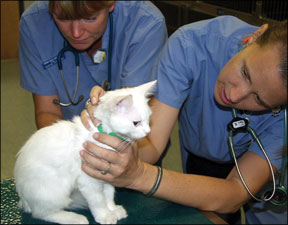The feline pancreas is a slender, pale pink, V-shaped strip of tissue that is tucked snugly within the right-hand side of a cats abdomen, at a junction between its kidney and its duodenum (the beginning portion of the intestine as it leaves the stomach). Despite the comparatively small size of this organ, which weighs just a few ounces, your cats good health depends on its proper functioning. 288 Indeed, any disease or injury that significantly compromises the efficiency of this little organ is very likely to prove fatal. The most frequently observed among all lethal threats associated with this organ is known as feline pancreatitis. It’s important to recognize the signs of this disease. A Complex Function The pancreas plays two crucially important roles, one of which is the 
The other role that the pancreas plays is the exocrine function, the major activity of which is to produce and secrete a potent liquid rich in chemicals (enzymes) that eventually pass out of the pancreas and into the small intestine to enable the digestion of fats, proteins and carbohydrates. While in the pancreas, the digestive chemicals are sequestered within tiny droplets that prevent their coming into direct contact with pancreatic tissue. Moreover, these potent enzymes are biochemically programmed to remain inactive until after they have been secreted and have traveled via the pancreatic duct into the small intestine. The process of enzyme secretion out of the organ may begin with a cats hunger merely thinking about food will suffice. Or the process can start when the animal is already eating and swallowing food.
Acute pancreatitis is a disease of the exocrine system. It occurs when the digestive enzymes are released and start working while still inside the pancreas and begin digesting the organ itself, which is also made of fat, protein and carbohydrate.
Disease Progression
The most common clinical signs of acute pancreatitis include lethargy, loss of appetite, dehydration and low body temperature. Although cats experiencing pancreatitis typically do not vomit, they may show signs of abdominal pain. They may also have jaundice a yellowish tinge to their skin, gums, the whites of their eyes, and the tissue inside their mouths.
An affected cat can have a perfectly normal pancreas but suddenly develop for no obvious reason a very severe case of acute pancreatitis and die as a result of that single attack. Or it may recover and never experience a problem with its pancreas again.
Often, however, an affected cat will recover from an initial acute attack and subsequently experience intermittent bouts of the disease over time. With each occurrence, there will be less inflammation, but there will be gradual scarring of the pancreatic tissue, which could eventually take its toll on the organs ability to function. Those cats that transition to this chronic form of pancreatitis which may rarely lead to exocrine pancreatic insufficiency will be afflicted to some extent for the remainder of their lives. According to Francis Kallfelz, DVM, a professor of veterinary nutrition at Cornell Universitys College of Veterinary Medicine, this disorder is incurable, due to the irreversible loss of organ tissue. On a brighter note, however, the life of a cat with exocrine insufficiency can be extended and its overall health maintained by means of a diet supplemented with the digestive enzymes that its pancreas can no longer produce (see sidebar).
Mysterious Origins
Although it is the most common disorder of the feline pancreas, studies have indicated that acute pancreatitis occurs in fewer than two percent of the general cat population. Cats of both sexes and of all ages and breeds appear to be similarly vulnerable.
The cause of more than 90 percent of cases of acute pancreatitis is never found, although studies have indicated that the condition can occasionally be triggered by the ingestion of insecticides or other toxins. Physical trauma involving the pancreas an animals being hit by a car, for example, or falling from a great height has been associated with the onset of this disease. Various disorders, such as feline infectious peritonitis, have also been cited as possible causes of pancreatitis, as have adverse drug reactions, inflammatory bowel disease and parasitic infection.
Diagnostic Measures
The standard diagnostic procedure in cases of suspected acute pancreatitis will involve a medical history of the animal, thorough physical examination, bloodwork and possibly ultrasound. While radiography cannot yield a definitive diagnosis, since pancreatic abnormalities are not readily perceptible on X-rays, it is sometimes useful in ruling out other disorders, such as an intestinal obstruction, that can have signs similar to those of pancreatitis.
In many cases, the only way a sure diagnosis can be made is through a tissue sample (biopsy), but this involves a surgical procedure that may not be advisable for a seriously ailing animal. Thus, a veterinarian may have to settle for a presumptive diagnosis of pancreatitis based on the physical exam, bloodwork and ultrasound.
While no uniformly effective treatment yet exists for acute pancreatitis, an affected cat will have to be hospitalized for several days at least while treatment proceeds and, it is hoped, the animals spirits gradually pick up and it resumes its normal eating habits. The mainstays of supportive treatment are intravenous fluid therapy and feeding the patient through tubes leading directly into its stomach if necessary the main goal of which is to make sure that the animal keeps getting its nutrition.
The eventual outcomes associated with feline pancreatitis depend to a great extent on several factors: the severity of the initial assault and its lasting effects; the extent to which chronic pancreatitis and accompanying conditions such as exocrine insufficiency become life-threatening; and the amount of time (and money) an owner is willing to invest in the long-term care of a cat afflicted with this disorder.
v

